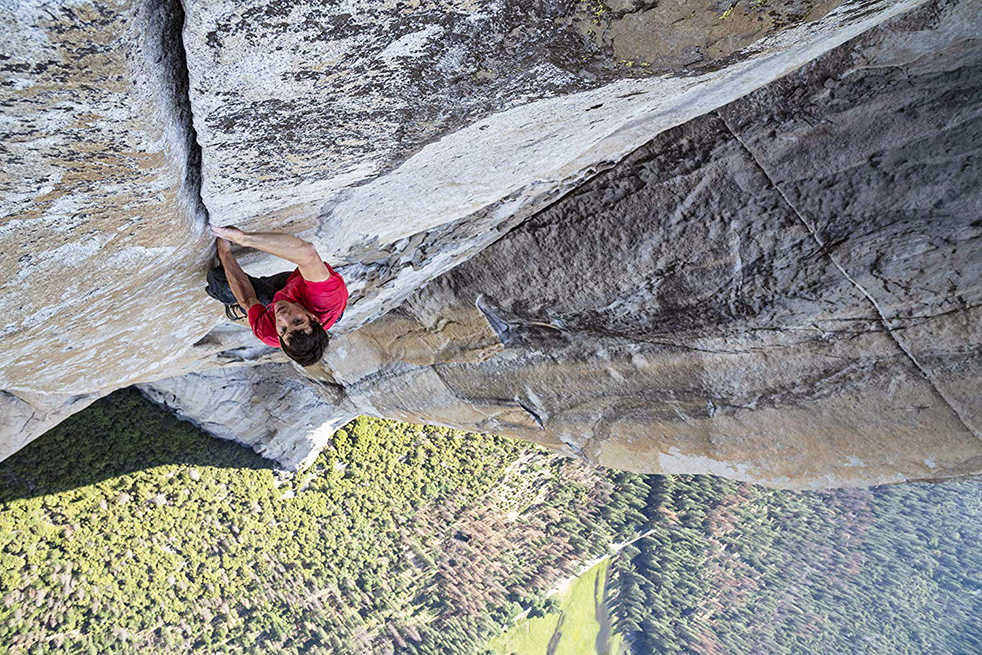On June 3, 2017, Alex Honnold climbed 3,000 feet above the floor of Yosemite National Park without the protection of ropes to secure him to the natural stone wall he was climbing. He became the first person to dangerously “free solo” the famous El Capitan wall, meaning he didn’t have any gear except climbing shoes and a chalk bag tied around his waist.
Over a year later, Free Solo, a National Geographic documentary about Honnold’s journey, was released and captivated both the climbing and non-climbing worlds. The film chronicles more than a year of Honnold’s life preceding the famous ascent, revealing a great deal about his motivations, personal relationships and complex emotions surrounding the ascent. Impressively, the film has kept audiences gripped with anticipation for all 97 minutes of its run time, even with most viewers knowing how it will end.
“Free Solo” was featured at the Toronto International Film Festival, Telluride Film Festival and the LA Film Festival earlier this year. It premiered in Atlanta at AMC Phipps Plaza and the Midtown Arts Center on Oct. 12.
The film was created by Jimmy Chin and Elizabeth Chai Vasarhelyi, two filmmakers known for their stunning work in adventure and climbing documentaries. The filmmakers themselves were necessary characters in the documentary. Many scenes featured them discussing the very real possibility that Honnold would fall to his death while they recorded, powerless to help.
Other scenes focus on Honnold and his girlfriend, Sanni McCandless, sitting in a van outfitted as a kitchen, bedroom and workout space. They discuss McCandless’s fears and Honnold’s stubborn tenacity. These scenes highlight Honnold’s mindset, which is so foreign to most of the film’s viewers; he chooses to climb without protection and at great heights because it makes him feel most alive, and no emotional relationship will hold him back.
On all sides, “Free Solo” skillfully shows the complex emotion involved in the attempt of such a formidable feat. It is not just a movie about an athletic endeavor; it is about the tangled threads of athleticism, artistic desire and personal relationships involved in doing something that has never been done before.
Paired with these emotional scenes were sequences of Honnold’s training, which involved endless repetition of moves on the route. The audience sees him fall over and over, even when secured by a rope. Tension builds with each fall during training, as everyone watching knows that any such slip will be catastrophic when Honnold climbs the route without protection.
There was considerable mental preparation on Honnold’s end as well. A visualization takes viewers through the different sections of the route as Honnold’s voiceover shows that he can recite each and every move from memory.
The last twenty minutes of the film take viewers through Honnold’s actual ascent of Free Rider, the route that winds its way up the El Capitan wall. There is palpable tension in the air of the theater, as everyone watches Honnold execute moves he has practiced hundreds of times. The audience laughs with relief and cheers when he finishes a move that had given him trouble before. Beautiful shots of Honnold, climbing utterly alone with tree tops thousands of feet below, take the audience’s breath away.
The anxiety of the audience is mirrored in the scenes which follow the filmmakers themselves, some of whom have to physically turn away from Honnold as he completes certain tough sequences. A collective exhale shudders through the entire theater as Honnold finally, finally steps onto level ground at the top of the daunting, sheer face, his task done.
It is a mark of Chin and Vasarhelyi’s excellence as filmmakers that “Free Solo” is able to entirely envelop an audience full of people who already know how the movie will end.
